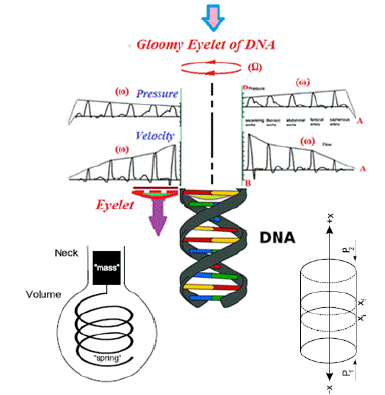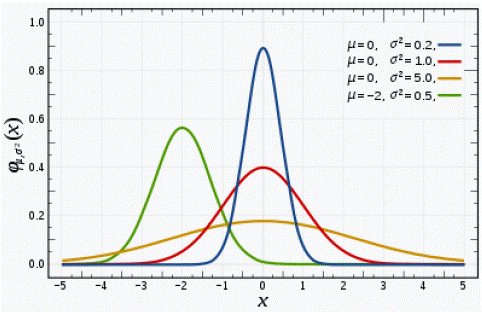
Review Article
Austin J Microbiol. 2024; 9(2): 1053.
Exploring the Impact of Induced Vibrations and Gloomy Eyelets within DNA on Pathogen Behavior: Insights into Quasi-Pathogens
Jean-Marc Sabatier¹; Farzan Amini²*
¹Université Aix-Marseille - Institut de Neuro-Physiopathologie (INP) - UMR 7051, Faculté de Pharmacie, 27 Bd Jean Moulin, 13385 Marseille Cedex, France
²exERT, Bd Pierre Dramard, 13015 Marseille, France
*Corresponding author: Farzan Amini exERT, Bd Pierre Dramard, 13015 Marseille. France. Email: f.amini@protonmail.ch
Received: May 23, 2024 Accepted: June 19, 2024 Published: June 26, 2024
Abstract
This paper delves into the introduction of two Quasi-Pathogens and investigates their role in pathogen behavior. We explore how induced vibrations from gloomy eyelets can facilitate the transfer of pathogens behavior from one point to another along the Gaussian Distribution Curve. Additionally, we hypothesize that particle A encompasses Quasi-Pathogens, and in regions impacted by the tiny distortion of nano spacetime, where the presence of particle A is diminished, induced vibrations may give rise to new oscillations on the Complementary Gaussian Distribution curve. This suggests the emergence of a new quasi particle, labeled as B, representing Subtle Quasi-Pathogens.
Keywords: Quasi-Pathogens; Subtle Quasi-Pathogens; Gloomy Eyelet (GE); Warp Drive Hydro (WDH) model; Swinging Spring model; Co-Moving Reference Frame(CMRF); Rankine Model; Pseudo-Spherical Geometry; Spacetime
Introduction
Induced vibrations, ubiquitous in various systems, have recently garnered significant interest in biomedical research due to their potential implications for understanding pathogens behavior and cellular disturbances. This paper presents an investigation into the complex interplay between induced vibrations, Gloomy Eyelets (GE) within cell nuclei, and their impact on cellular dynamics. Drawing from interdisciplinary insights spanning biophysics, nanotechnology, and cellular biology. Our analysis sheds light on the emergence of GE, nano distortions of space-time, and their interactions with surrounding mediums such as left ventricular and DNA. By applying Hamiltonian equations, principles of fluid dynamics, and insights from previous studies, we elucidate the intricate dynamics of coupled GE and their implications for cellular disturbances (Figure1). Furthermore, we explore the generation of pressure waves and rotational frequencies within DNA, uncovering the role of Nano Latent Buoyancy in cellular processes. This study offers novel insights into pathogens behavior, cellular disturbances, and their relevance to human health, with potential applications in medical diagnostics and therapeutic interventions.
The study aims to introduce and understand the behavior of two Quasi-Pathogens within the context of induced vibrations and Gloomy Eyelets. By exploring their interactions and implications, we aim to shed light on their role in pathogens behavior and cellular disturbances [1-4].
Synchronization Phenomena and the Rankine Model
The synchronization between the beat frequency (ω) of blood pressure within blood vessels and the rotation speed (Ω) of the left ventricle, as described by the Rankine model, leads to a notable event: a sudden pressure drops and the rapid formation of cavities within the Warp Drive Hydro (WDH) medium. This intriguing phenomenon is anticipated to manifest when the swinging spring frequency (Ω) of DNA converges with the beat frequency (ω) of blood pressure in blood vessels, potentially inducing a sudden pressure drop, akin to an accelerated cavity, as postulated by the Rankine model. Subsequently, DNA undergoes longitudinal expansion, giving rise to the creation of nano-scale cavities accompanied by a reduction in internal pressure. This sequence of events sets the stage for the emergence of Gloomy Eyelets (GE) within the WDH model of DNA (Figure 1).
Within Gloomy Eyelets, photons generated by Quantum Electro Dynamic (QED) processes might play a role in shaping Co-Moving Reference Frame (CMRF) dynamics. These occurrences within Gloomy Eyelets typically signify tiny distortions of space-time within the cell nucleus. Gloomy Eyelets traverse a trajectory within the Pseudo-Spherical trajectory of the Warp Drive Hydro (WDH) model, as prescribed by the Rankine model.
Moving from theoretical constructs to tangible analogies, consider the Helmholtz resonator: an assembly comprising a hollow neck appended to an empty volume. To comprehend the behavior of air within a Helmholtz flask, envision a mass oscillating on a spring. The oscillating air within the neck mirrors the mass, while the air confined within the cavity resembles the spring. Newton's Second Law allows us to formulate an equation representing the mass of air oscillating within the neck of the cavity when subject to an external sinusoidal driving force as follows:


In a driven, damped spring-mass system, three forces come into play. The driving force, f(t)eiωt, propels the mass to oscillate in sinusoidal fashion, its motion characterized by the angular frequency ω and time t. Resisting the mass's motion through the air is the force denoted as Rv, where R represents resistance and v denotes velocity. The third force, kx, embodies the spring's restorative nature, where k signifies the spring constant and x symbolizes displacement

The amplitude of oscillation in the spring-mass system is influenced by mechanical resistance (see equation 3). The primary source of resistance is the air's opposition to the mass's movement. The quality factor, q, delineates the amplitude of oscillation concerning resonance frequency and resistance. High-quality factor systems exhibit minimal resistance and amplify oscillation at resonance, whereas low-quality factor systems dampen response at resonance, characterized by a broader peak in the resonance curve [5-10].
Main Model
Introduction to Probability Distributions
In probability theory and statistics, a probability distribution is a fundamental concept that provides a mathematical description of a random phenomenon. It is a function that assigns probabilities to the various possible outcomes of an experiment, as illustrated in Figure 1. The sample space of the experiment encompasses all potential outcomes, and the probability distribution assigns a probability to each event within this space. This framework allows for the quantification and analysis of uncertainty and variability in random processes [11].

Figure 1: The rotating standing wave within the cell nucleus, characterized by its rotational speed (O) within the WDH Model, interacts with the pulsating pressure wave within the blood vessels, also determined by its rotational speed (?). Additionally, the behavior of air inside a Helmholtz resonator is taken into consideration.
Dynamics of Induced Vibrations
Our research delves into the novel exploration of how induced vibrations impact pathogens behavior associated with Gloomy Eyelet. Gloomy Eyelets are hypothesized to be areas within the biological medium that exhibit unique vibrational characteristics. These vibrations, with frequency excitation denoted as ω (see equation 2), propagate specific pathogens behavior into the biological medium along a Gaussian curve, a common probability distribution that describes how values are distributed symmetrically around a mean in a bell-shaped manner (Figure 1).

Figure 2: Gaussian distribution Curve - probability density function of Quasi-Pathogens.
We propose a theoretical framework where quasi-particle A is posited to harbor Quasi-Pathogens. These Quasi-Pathogen are not fully developed pathogens but have the potential to evolve into more active forms under certain conditions.


Induced vibrations caused by Gloomy Eyelets, which include the effects of tiny distortions in nano spacetime, can generate new oscillations through the excitation of frequency ω' in pathogens (see equation 5). This phenomenon is expected to induce new pathogen behaviors in the biological medium [1,3].
These new oscillations in the biological medium are modeled on the Complementary Gaussian Distribution curve, suggesting that as the environment undergoes slight time dilation, it gives rise to quasi-particle B, which represents Subtle Quasi-Pathogens.
Propagation of Pathogen Behavior
When induced vibrations reach pathogens, they generate multiple frequencies. Among these, the resonant frequency that aligns between the pathogen and the gloomy eyelets is crucial. This frequency belongs to a continuum of fixed frequencies, which allows the natural frequencies of the pathogen to be transmitted across the system. This resonant transmission facilitates the propagation of the pathogen's behavior through the biological medium.
Furthermore, the interaction of these vibrations with regions experiencing spacetime distortion enables the transfer of the cryptic footprint of the pathogen's behavior. This cryptic footprint refers to subtle, often undetectable changes in behavior and structure induced by the pathogen. This transfer mechanism allows these changes to affect other points and cells within the system, subtly propagating the pathogen's influence and altering cellular dynamics in various locations.
Results
Our findings suggest a significant interplay between induced vibrations, gloomy eyelets, and pathogen behavior. We demonstrate how induced vibrations can serve as a mechanism for transferring pathogen behavior along the Gaussian Distribution curve and potentially giving rise to Subtle Quasi-Pathogens on the Complementary Gaussian Distribution curve. These insights deepen our understanding of pathogens dynamics and highlight the intricate relationship between induced vibrations and cellular disturbances. This knowledge could pave the way for new strategies in managing and mitigating pathogen effects, particularly in medical and biological contexts.
Discussion
The discussion delves into the implications of our findings for understanding pathogen behavior and potential therapeutic interventions. We explore the significance of induced vibrations and gloomy eyelets as key factors influencing pathogens dynamics and discuss the broader implications for biomedical research and healthcare. Additionally, we consider the implications of the emergence of particle B and its role in pathogen behavior and cellular disturbances.
Conclusions
In conclusion, this study introduces the concept of two Quasi-Pathogens and elucidates their role in pathogen behavior within the context of induced vibrations and Gloomy Eyelets. Our findings contribute to a deeper understanding of pathogen dynamics and hold potential implications for biomedical research and therapeutic interventions. Continued research in this area is essential for further unraveling the complexities of pathogen behavior and cellular disturbances.
References
- Sabatier MJ, Amini F. Emergence of Gloomy Eyelet inside DNA. Biophysica. 2023; 3: 35-45.
- Sabatier MJ, Amini F. Gloomy Eyelet Along with the Latent Buoyancy Inside Nucleus Cell. Lupine Online Journal of Medical Sciences. 2023: 6.
- Sabatier MJ, Amini F. Coupling Gloomy Eyelets in the Nucleus of Cells and Forming Unknown Distinct Structure (UDS). Austin J Anal Pharm Chem. 2023; 10: 1155.
- Richoux O, Lombard B, Mercier J. Generation of acoustic solitary waves in a lattice of Helmholtz resonators. 2014.
- Smith H. A Thermoacoustic Approach to Exploring Resonance. University of Central Arkansas. 2008.
- Felicetti MA, Piantino F, Coury JR, Aguiar ML. Influences of Removal Time and Particle Size on The Particle Substrate Adhesion Force. Brazilian Journal of Chemical Engineering. 2008.
- Ridgely TC. On the Origin of Inertia; Galilean Electrodynamics; 2963 Maple Avenue, Fullerton, CA 92835; January/February 2001.
- Haramein N, Rauscher EA. The Origin of Spin: A Consideration of Torque and Coriolis Forces in Einstein’s field Equations and Grand Unification Theory. Beyond The Standard Model: Searching for Unity In Physics. 2005.
- Richoux O, Lombard B, Mercier J. Generation of acoustic solitary waves in a lattice of Helmholtz resonators. 2014.
- Smith H. A Thermoacoustic Approach to Exploring Resonance. University of Central Arkansas. 2008.
- Lyon A. Why are Normal, Distributions Normal?. The British Journal for the Philosophy of Science. 2014.